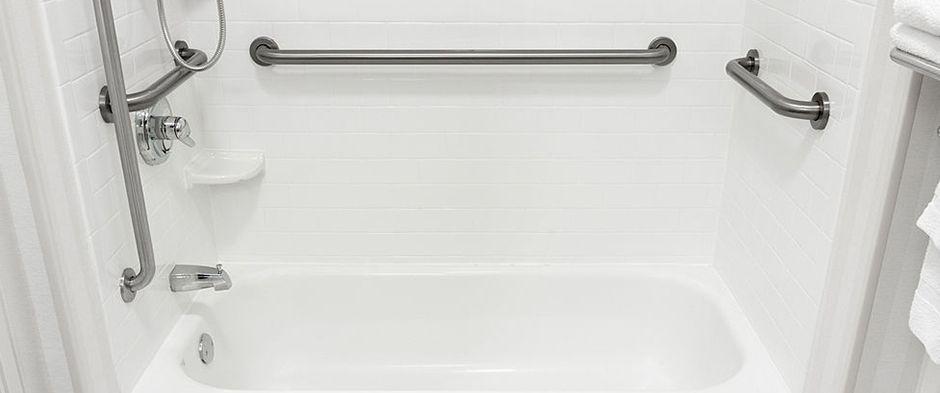
Choosing Practical Disability Aids for Balance in the Bathroom
Sally Madeley-Carr, OT12 Feb 2020
Growing older brings a host of new challenges which we may not see coming. As our strength, balance and flexibility starts to reduce, some daily tasks may become tricky. Being comfortable using the toilet, bath, shower and sink is something most people take for granted. So when a physical issue gets in the way, we need to be open-minded about practical methods to overcome the problem.
With the goal of long-term independence, it's important to be aware of the type of bathing and washing aids now available. While each on their own may only solve a small problem, together they may grow to be vital tools in your bathroom routine.
There are numerous conditions which lead to impaired balance. Hard angular surfaces, together with a high moisture content found in bathrooms, makes it a potentially hazardous environment. Falls can lead to broken bones and other injuries.
There are numerous bathroom aids which help maintain your balance. A key example is the grab rail. These provide useful points of physical support and come in a number of designs, all of which have slightly different benefits and applications.
Most types are discreet in design, helping them blend into your bathroom décor without drawing too much attention.
6 key bathroom support rails
1. Straight grab rails
These fix directly to the wall and run in a straight line. They can be positioned vertically, horizontally or somewhere in between, depending on your preference. They are usually made of metal or sturdy plastic. As they screw directly the wall, it is important they're installed by a qualified professional.
They provide a general balance aids for example when the person is using the sink or getting dressed or undressed.
You may also use rails to pull or push yourself up from a sitting position, for instance when using the toilet or bath. They can be effective as a support to lower yourself into a sitting position.
Vertical wall-mounted rails are a great balancing aid and may help then getting dressed or undressed. Before installation, think carefully about which placement is likely to help you the most.
They can be useful for dressing or undressing, standing while using the toilet or next to the sink.
You may find that fitting the rail at a diagonal angle creates a comfortable position for you to grip. There are angles which you may find keep your wrist in a neutral shape while holding the rail. This may in turn reduce stress on the joint and improve comfort.
For elderly people with certain frailties, these seemingly small considerations may actually make a big difference.
2. Angled rails
Grab rails are available with a bend either in the middle or towards one end. The bend can be at 90 degrees or commonly at a shallower angle.
Most people opt to keep the lower section horizontal, with the other end tipping upwards. This part is generally used as the hand-hold. It allows for a neutral wrist position and the possibility of leaning the forearm along the flat section of rail for increased support.
3. Floor-to-ceiling-rails
These rails are long vertical poles which extend from the floor to the full height of the room. While sometimes used in bedrooms, they are also effective in the bathroom.
Some models stand alone, while others have an additional horizontal rails fixed to the pole, usually around waist height. In some cases this extra rail swivels so that it extends in the direction of your choosing.
As with the other types of rail, it's important they are fitted in the most useful practical position. The idea is to find a spot where they will not get in the way, yet offer necessary support when needed.
4. Bath rails and tap rails
Bath rails fit to the bath itself, usually about midway down its length. Screw clamps hold it in place and create a support bar which reaches above the height of the side of the bath. It is great for holding onto when either entering or exiting the bathtub.
This type of rail can useful to lean against when getting toweling yourself or when getting dressed or undressed.
A tap rail fits within the bathtub itself, in baths with taps at one end. The rail folds down across part of the bath, providing a leverage or balancing support. These rails are still popular but not as common as they once were. They fold up against the wall when not in use.
5. Wall mounted fold-down rails
These tend to be fairly substantial pieces of equipment. They are usually of an elongated U-shaped design of large diameter metal tubing and installed directly next to the toilet.
When deployed, they provide a robust horizontal support rail. You often see them in disabled toilets and hospitals, but they can be effective in domestic settings too.
One advantage of this type of rail is that it can be fitted either side of the toilet, not necessarily close to an adjacent wall. Various sizes are available, depending on how far you require the rail to protrude from the wall.
Some are available with a plinth, making it possible to floor-fix them in the desired position.
Most models can be flipped up against the wall when not in use. A locking mechanism keeps them in a vertical position so they're not prone to fall down by accident.
6. Toilet frames
These frames are usually above waist height and are positioned immediately around the WC pedestal. They can be free-standing or fixed, providing a balance aid as you sit down or stand up.
Available in fixed or width-adjusting models, they are a tried and tested aid to support someone using the toilet. Essential Aids' offers an extensive range of high quality toilet frames.
Other things to consider with support rails
When fixing grab rails in wet environments, remember to use non-corrosive screws. Even if the heads of the screws are covered by caps, rust staining may leak and leave marks on the wall below.
Another consideration when choosing a grab rail is the texture of the surface. Some people prefer rails with a non-smooth surface. Smooth rails can be slippery when wet so ridged or high friction coatings may well be beneficial. Plastic rails with non-slip surfaces also tend to feel warmer to the touch.
Seating in the bathroom including perching stools
If you have compromised balance, being able to sit either while washing or drying off is a big advantage. Essential Aids has plenty of shower seat options designed for just this task.
Bath boards
These straddle the width of the bath, providing somewhere to sit while under the shower. They are available in various widths so you will be able to find to find one for your bath. Fixing by clamps at either end, bath boards provide a strong seating platform if you have difficulty balancing while standing up.
Shower stools and shower chairs
These fit inside the shower cubicle and like bath boards allow the user to sit for the duration of a shower. They are usually lightweight and made from non-corrosive materials.
It's important to ensure the floor of your shower is suitable. While modern stools will have non-slip feet, raised shower tray drainage patterns can make the floor uneven. In some cases, this may make it hard to find a stable position for a stool.
While shower stools are available with three legs, at Essential Aids we feel that four legged models are preferable. They are significantly more stable and less prone to tipping over, a key factor for those with limited balance.
Most of our shower stools have drainage holes in the seat itself. This allows access water to run off, reducing the chance of slipping.
If a stool is either too small or perhaps doesn't offer the required stability, more substantial seating is available for shower cubicles. Some models are available with a wider footprint plus back and armrests like Essential Aids' best-selling Etac Clean Durable Shower Commode Chair.
Remember, these larger chairs tend to take up more space, so ensure you have adequate room in your shower cubicle.
Fold-down shower seats
If space is an issue, another option is a built-in seat that flips up against the wall when not in use. These are great space savers and remove the need to take a chair or stool in and out of the shower. They are ideal if the cubicle is used regularly by more than one person.
The weight-bearing tolerance of a fold-up shower seat is variable, so double check the specification before installing a specific model. Some have fold-down legs which drop into place, providing extra support, making them better for heavier individuals.
Perching stools for the sink
A perching stool is an innovative piece of equipment allowing the user 'sit-stand'. Often used at kitchen worktops, they also work effectively at a bathroom sink.
This type of shower seat is usually height adjustable and much taller than regular stools. They have a tilted seat, allowing the user to 'perch' on the front edge. This provides a balance aid while standing at the sink.
Essential Aids has an extensive range of Perching Stools in the Bathroom section.

Sally Madeley-Carr, OT
Sally qualified as an Occupational Therapist in 1996 and is a well-respected professional in the field of rehabilitation equipment and living aids. She has worked in private practice and within the NHS, developing a broad experience with adults and children. Click here for Sally's registration with the Health and Care Professions Council. The HCPC regulates health, psychological and social work professionals in the UK.